Modeling the Distribution and Richness of Mammalian Species in the Nyerere National Park, Tanzania
Abstract
1. Introduction
2. Materials and Methods
2.1. Study Area
2.2. Distribution Models
2.2.1. Presence and Background Records
2.2.2. Description of Environmental Variables
Sources and Derivation of Environmental Predictors
Variable Selection and Multicollinearity Analysis
2.2.3. Model Fitting
2.2.4. Model Evaluation
2.2.5. Staked Species Distribution Model
3. Results
3.1. Distribution Models Selection
3.2. Species Distribution Maps
3.3. Species Richness
4. Discussion
4.1. Field Surveys and Presence Data
4.2. Integration of Remote Sensing and Environmental Predictors in SDMs
4.3. Model Fitting and Evaluation
4.4. Species Distribution Patterns and Environmental Drivers
4.5. Species Richness Patterns in NNP: Insights from SSDMs
4.6. Climate Change Vulnerability
4.7. Landscape Connectivity and Conservation Implications
4.8. Limitations and Future Directions
5. Conclusions
Supplementary Materials
Author Contributions
Funding
Data Availability Statement
Acknowledgments
Conflicts of Interest
References
- WWF. Living Planet Report 2020; WWF: Gland, Switzerland, 2020; ISBN 9782940529995. [Google Scholar]
- Brink, A.B.; Bodart, C.; Brodsky, L.; Defourney, P.; Ernst, C.; Donney, F.; Lupi, A.; Tuckova, K. Anthropogenic Pressure in East Africa-Monitoring 20 Years of Land Cover Changes by Means of Medium Resolution Satellite Data. Int. J. Appl. Earth Obs. Geoinf. 2014, 28, 60–69. [Google Scholar] [CrossRef]
- Rija, A.A.; Critchlow, R.; Thomas, C.D.; Beale, C.M. Global Extent and Drivers of Mammal Population Declines in Protected Areas under Illegal Hunting Pressure. PLoS ONE 2020, 15, e0227163. [Google Scholar] [CrossRef]
- CBD. Global Biodiversity Outlook 3; A Report by the Secretariat of the Convention on Biological Diversity, Montréal; Secretariat of the Convention on Biological Diversity: Montreal, QC, Canada, 2010; ISBN 9292252208. [Google Scholar]
- Leadley, P.; Gonzalez, A.; Obura, D.; Krug, C.B.; Londoño-Murcia, M.C.; Millette, K.L.; Radulovici, A.; Rankovic, A.; Shannon, L.J.; Archer, E.; et al. Achieving Global Biodiversity Goals by 2050 Requires Urgent and Integrated Actions. One Earth 2022, 5, 597–603. [Google Scholar] [CrossRef]
- Bezeng, B.S.; Ameka, G.; Angui, C.M.V.; Atuah, L.; Azihou, F.; Bouchenak-Khelladi, Y.; Carlisle, F.; Doubi, B.T.S.; Gaoue, O.G.; Gatarabirwa, W.; et al. An African Perspective to Biodiversity Conservation in the Twenty-First Century. Philos. Trans. R. Soc. Lond. Ser. B Biol. Sci. 2025, 380, 20230443. [Google Scholar] [CrossRef] [PubMed]
- Nieto, M.; Hortal, J.; Martínez-Maza, C.; Morales, J.; Ortiz-Jaureguizar, E.; Pelaez-Campomanes, P.; Pickford, M.; Prado, J.L.; Rodríguez, J.; Senut, B.; et al. Historical Determinants of Mammal Diversity in Africa: Evolution of Mammalian Body Mass Distribution in Africa and South America During Neogene and Quarternary Times. In African Biodiversity; Springer: Boston, MA, USA, 2007; pp. 287–295. [Google Scholar] [CrossRef]
- Sofaer, H.R.; Jarnevich, C.S.; Pearse, I.S.; Smyth, R.L.; Auer, S.; Cook, G.L.; Edwards, T.C.; Guala, G.F.; Howard, T.G.; Morisette, J.T.; et al. Development and Delivery of Species Distribution Models to Inform Decision-Making. Bioscience 2019, 69, 544–557. [Google Scholar] [CrossRef]
- Murwendo, T.; Murwira, A.; Masocha, M. Modelling and Predicting Mammalian Wildlife Abundance and Distribution in Semi-Arid Gonarezhou National Park, South Eastern Zimbabwe. Ecofeminism Clim. Chang. 2020, 1, 151–163. [Google Scholar] [CrossRef]
- Lacher, T.E.; Davidson, A.D.; Fleming, T.H.; Gómez-Ruiz, E.P.; McCracken, G.F.; Owen-Smith, N.; Peres, C.A.; Vander Wall, S.B. The Functional Roles of Mammals in Ecosystems. J. Mammal. 2019, 100, 942–964. [Google Scholar] [CrossRef]
- Okello, M.M.; Manka, S.G.; D’aMour, D.E. The Relative Importance of Large Mammal Species for Tourism in Amboseli The Relative Importance of Large Mammal Species for Tourism in Amboseli National Park, Kenya. Tour. Manag. 2008, 29, 751–760. [Google Scholar] [CrossRef]
- Kideghesho, J.R. The Potentials of Traditional African Cultural Practices in Mitigating Overexploitation of Wildlife Species and Habitat Loss: Experience of Tanzania. Int. J. Biodivers. Sci. Manag. 2009, 5, 83–94. [Google Scholar] [CrossRef]
- Catherine, A.M.; Revocatus, M.; Hussein, S. Will Ngorongoro Conservation Area Remain a World Heritage Site amidst Increasing Human Footprint? Int. J. Biodivers. Conserv. 2015, 7, 394–407. [Google Scholar] [CrossRef]
- Gizachew, B.; Rizzi, J.; Shirima, D.D.; Zahabu, E. Deforestation and Connectivity among Protected Areas of Tanzania. Forests 2020, 11, 170. [Google Scholar] [CrossRef]
- Ma, L.; Wu, J.; Zhang, H.; Lobora, A.; Hou, Y.; Wen, Y. Conflict Governance between Protected Areas and Surrounding Communities: Willingness and Behaviors of Communities—Empirical Evidence from Tanzania. Diversity 2024, 16, 278. [Google Scholar] [CrossRef]
- Searle, C.E.; Strampelli, P.; Haule, L.; Parsais, S.N.; Olesyapa, K.; Salum, N.D.; Ikanda, D.; Mtoka, S.; Hape, G.; Mathayo, D.; et al. Cheetahs in Tanzania’s Selous-Nyerere Ecosystem: Lack of Evidence for Current Persistence, and Reflections on Historical Status. Oryx 2023, 58, 532–536. [Google Scholar] [CrossRef]
- Mkwizu, K.H. Experiences and Enjoyment of National Parks: Study of Nyerere National Park in Tanzania. Int. Hosp. Rev. 2023, 38, 355–375. [Google Scholar] [CrossRef]
- Foya, Y.R.; Mgeni, C.P.; Kadigi, R.M.J.; Kimaro, M.H.; Hassan, S.N. Do Communities Understand the Impacts of Unlawful Bushmeat Hunting and Trade? Insights from Villagers Bordering Western Nyerere National Park Tanzania. Glob. Ecol. Conserv. 2023, 46, e02626. [Google Scholar] [CrossRef]
- Saanya, A.E.; Mulungu, L.S.; Massawe, A.W.; Makundi, R.H. Current and Potential Future Distribution of Small Mammals in the Selous Ecosystem, Tanzania. J. East Afr. Nat. Hist. 2023, 112, 47–62. [Google Scholar] [CrossRef]
- Grenié, M.; Violle, C.; Munoz, F. Is Prediction of Species Richness from Stacked Species Distribution Models Biased by Habitat Saturation? Ecol. Indic. 2020, 111, 105970. [Google Scholar] [CrossRef]
- Wang, R.; Sun, Y.; Zong, J.; Wang, Y.; Cao, X.; Wang, Y.; Cheng, X.; Zhang, W. Remote Sensing Application in Ecological Restoration Monitoring: A Systematic Review. Remote Sens. 2024, 16, 2204. [Google Scholar] [CrossRef]
- Borges, J.; Symeonakis, E.; Higginbottom, T.P.; Jones, M.; Cain, B.; Kisingo, A.; Maige, D.; Oliver, O.; Lobora, A.L. Assessing Habitat Suitability: The Case of Black Rhino in the Ngorongoro Conservation Area. Remote Sens. 2024, 16, 2855. [Google Scholar] [CrossRef]
- Saanya, A.; Mulungu, L.; Sabuni, C.; Massawe, A.; Makundi, R. Effects of Prescribed Burning on Rodents in an East African Woodland Ecosystem. Afr. J. Ecol. 2023, 61, 583–594. [Google Scholar] [CrossRef]
- Fick, S.E.; Hijmans, R.J. WorldClim 2: New 1-Km Spatial Resolution Climate Surfaces for Global Land Areas. Int. J. Climatol. 2017, 37, 4302–4315. [Google Scholar] [CrossRef]
- Riggio, J.; Foreman, K.; Freedman, E.; Gottlieb, B.; Hendler, D.; Radomille, D.; Rodriguez, R.; Yamashita, T.; Kioko, J.; Kiffner, C. Predicting Wildlife Corridors for Multiple Species in an East African Ungulate Community. PLoS ONE 2022, 17, e0265136. [Google Scholar] [CrossRef]
- Song, L.; Frazier, A.E.; Estes, A.B.; Estes, L.D. A Multi-Scale Approach for Integrating Species Distribution Models with Landscape Connectivity to Identify Critical Linkage Zones for African Savanna Elephants (Loxodonta Africana). Ecol. Modell. 2025, 507, 111198. [Google Scholar] [CrossRef]
- Lamprey, R.; Ochanda, D.; Brett, R.; Tumwesigye, C.; Douglas-Hamilton, I. Cameras Replace Human Observers in Multi-Species Aerial Counts in Murchison Falls, Uganda. Remote Sens. Ecol. Conserv. 2020, 6, 529–545. [Google Scholar] [CrossRef]
- COWI Tanzania Ltd. Environmental and Social Management Framework for the Resilient Natural Resources Management for Tourism and Growth Project (P150523-PPA-C-07); Prepared for the Ministry of Natural Resources and Tourism, Tanzania; COWI Tanzania Ltd.: Dar es Salaam, Tanzania, 3 August 2017. [Google Scholar]
- Foya, Y.R.; Mgeni, C.P.; Kadigi, R.M.J.; Kimaro, M.H.; Hassan, S.N. The Knowledge about the Potential Health Risks of Illegal Bushmeat Activities among Local Communities Adjacent to Western Nyerere National Park, Tanzania. Open J. Ecol. 2023, 13, 22–36. [Google Scholar] [CrossRef]
- Bigirwa, D.; Roden Msese, L.; Rwakalaza, R.; Bilame, O. Measuring the Economic Use Values of Recreation Resources in Protected Areas, Evidence from Nyerere National Park in Tanzania. Am. J. Environ. Resour. Econ. 2021, 6, 54–65. [Google Scholar] [CrossRef]
- Searle, C.E.; Strampelli, P.; Hape, G.; Elisa, M.; Mathayo, D.; Ikanda, D.; Mtoka, S.; Lobora, A.L. Spatially Explicit Camera Trap-Based Lion Monitoring in Tanzania ’ s Selous–Nyerere Landscape. J. Zool. 2025, 1–12. [Google Scholar] [CrossRef]
- TAWIRI. Aerial Wildlife Survey of Large Animals and Human Activities in the NyerereSelousMikumi Ecosystem, Dry Season 2022; Tanzania Wildlife Research Institute: Arusha, Tanzania, 2023. [Google Scholar]
- Baldus, R.D.; Hahn, R. The Selous–Niassa Wildlife Corridor in Tanzania: Biodiversity Conservation from the Grassroots. Practical Experiences and Lessons from Integrating Local Communities into Trans-Bounday Natural Resources Management; CIC Technical Series Publication No.6; International Council for Game and Wildlife Conservation: Budakeszi, Hungary; Food and Agriculture Organization of the United Nations: Rome, Italy, 2009; 48p. [Google Scholar]
- Mpanduji, D. Distribution and Movements of Elephants and Other Wildlife in the Selous-Niassa Wildlife Corridor, Tanzania; Tropical Ecology Support Programme, GTZ: Eschborn, Germany, 2004. [Google Scholar]
- Growcott, J.; Lobora, A.; Markham, A.; Searle, C.E.; Wahlström, J.; Wijers, M.; Simmons, B.I. The Secret Acoustic World of Leopards: A Paired Camera Trap and Bioacoustics Survey Facilitates the Individual Identification of Leopards via Their Roars. Remote Sens. Ecol. Conserv. 2024, 1–14. [Google Scholar] [CrossRef]
- Norton-Griffiths, M. Counting Animals. Handbook No.1; African Wildlife Foundation: Nairobi, Kenya, 1978. [Google Scholar]
- Benavides Rios, E.; Sadler, J.; Graham, L.; Matthews, T.J. Species Distribution Models and Island Biogeography: Challenges and Prospects. Glob. Ecol. Conserv. 2024, 51, e02943. [Google Scholar] [CrossRef]
- Dormann, C.F.; Bobrowski, M.; Dehling, D.M.; Harris, D.J.; Hartig, F.; Lischke, H.; Moretti, M.D.; Pagel, J.; Pinkert, S.; Schleuning, M.; et al. Biotic Interactions in Species Distribution Modelling: 10 Questions to Guide Interpretation and Avoid False Conclusions. Glob. Ecol. Biogeogr. 2018, 27, 1004–1016. [Google Scholar] [CrossRef]
- Fern, R.R.; Morrison, M.L.; Wang, H.H.; Grant, W.E.; Campbell, T.A. Incorporating Biotic Relationships Improves Species Distribution Models: Modeling the Temporal Influence of Competition in Conspecific Nesting Birds. Ecol. Modell. 2019, 408, 108743. [Google Scholar] [CrossRef]
- Jeza, G.T.; Bekele, A. Seasonal Distribution Model of African Elephants (Loxodonta Africana) under a Changing Environment and Land Use in Omo National Park, Ethiopia. J. Wildl. Biodivers. 2023, 7, 96–117. [Google Scholar] [CrossRef]
- Roug, A.; Muse, E.A.; Clifford, D.L.; Larsen, R.; Paul, G.; Mathayo, D.; Mpanduji, D.; Mazet, J.A.K.; Kazwala, R.; Kiwango, H.; et al. Seasonal Movements and Habitat Use of African Buffalo in Ruaha National Park, Tanzania. BMC Ecol. 2020, 20, 6. [Google Scholar] [CrossRef] [PubMed]
- Gomes, V.H.F.; Ijff, S.D.; Raes, N.; Amaral, I.L.; Salomão, R.P.; Coelho, L.D.S.; Matos, F.D.D.A.; Castilho, C.V.; Filho, D.D.A.L.; López, D.C.; et al. Species Distribution Modelling: Contrasting Presence-Only Models with Plot Abundance Data. Sci. Rep. 2018, 8, 1003. [Google Scholar] [CrossRef] [PubMed]
- Chan, A.N.; Leimgruber, P.; Werner, K.; Stabach, J.; Wittemyer, G. Identification of Landscape Features Structuring Movement Connectivity for Namibian Elephants. Landsc. Ecol. 2024, 39, 148. [Google Scholar] [CrossRef]
- Chung, O.S.; Lee, J.K. Assessing the Distribution and Richness of Mammalian Species Using a Stacking Species Distribution Model in a Temperate Forest. Animals 2024, 14, 759. [Google Scholar] [CrossRef]
- Wan, Z.; Hook, S.; Hulley, G. MOD11A2 MODIS/Aqua Land Surface Temperature and Emissivity 8-Day L3 Global 1km SIN Grid V061; NASA Land Processes Distributed Active Archive Center: Sioux Falls, SD, USA, 2021. [Google Scholar] [CrossRef]
- Gorelick, N.; Hancher, M.; Dixon, M.; Ilyushchenko, S.; Thau, D.; Moore, R. Google Earth Engine: Planetary-Scale Geospatial Analysis for Everyone. Remote Sens. Environ. 2017, 202, 18–27. [Google Scholar] [CrossRef]
- Roy, D.P.; Kovalskyy, V.; Zhang, H.K.; Vermote, E.F.; Yan, L.; Kumar, S.S.; Egorov, A. Characterization of Landsat-7 to Landsat-8 Reflective Wavelength and Normalized Difference Vegetation Index Continuity. Remote Sens. Environ. 2016, 185, 57–70. [Google Scholar] [CrossRef]
- Reichle, R.; De Lannoy, G.; Koster, R.; Crow, W.; Kimball, J.; Liu, Q. SMAP L4 Global 3-Hourly 9 Km EASE-Grid Surface and Root Zone Soil Moisture Analysis Update, Version 4; NASA National Snow and Ice Data Center Distributed Active Archive Center: Boulder, CO, USA, 2018. [Google Scholar]
- Karamvasis, K.; Karathanassi, V. Soil Moisture Estimation from Sentinel-1 Interferometric Observations over Arid Regions. Comput. Geosci. 2023, 178, 105410. [Google Scholar] [CrossRef]
- Mueller, N.; Lewis, A.; Roberts, D.; Ring, S.; Melrose, R.; Sixsmith, J.; Lymburner, L.; McIntyre, A.; Tan, P.; Curnow, S.; et al. Water Observations from Space: Mapping Surface Water from 25years of Landsat Imagery across Australia. Remote Sens. Environ. 2016, 174, 341–352. [Google Scholar] [CrossRef]
- Max, A.; Jackson, S.; Cimentada, J.; Kuhn, M.M. Package ‘Corrr.’. 2022. Available online: https://CRAN.R-project.org/package=corrr (accessed on 17 April 2025).
- Dormann, C.F.; Elith, J.; Bacher, S.; Buchmann, C.; Carl, G.; Carré, G.; Marquéz, J.R.G.; Gruber, B.; Lafourcade, B.; Leitão, P.J.; et al. Collinearity: A Review of Methods to Deal with It and a Simulation Study Evaluating Their Performance. Ecography 2013, 36, 27–46. [Google Scholar] [CrossRef]
- Casas, E.; Martín-García, L.; Hernández-Leal, P.; Arbelo, M. Species Distribution Models at Regional Scale: Cymodocea Nodosa Seagrasses. Remote Sens. 2022, 14, 4334. [Google Scholar] [CrossRef]
- Gao, H.; Dou, H.; Wang, K.; Zhang, Y.; Hua, Y. Ensemble SDMs Reveal the Effect of Environmental Suitability and Nature Reserves on Conserving Chinese Pangolins in Guangdong, China. J. Nat. Conserv. 2024, 79, 126617. [Google Scholar] [CrossRef]
- Phillips, S.J.; Anderson, R.P.; Schapire, R.E. Maximum Entropy Modeling of Species Geographic Distributions. Ecol. Modell. 2006, 190, 231–259. [Google Scholar] [CrossRef]
- Wisz, M.S.; Hijmans, R.J.; Li, J.; Peterson, A.T.; Graham, C.H.; Guisan, A.; Elith, J.; Dudík, M.; Ferrier, S.; Huettmann, F.; et al. Effects of Sample Size on the Performance of Species Distribution Models. Divers. Distrib. 2008, 14, 763–773. [Google Scholar] [CrossRef]
- Barnes, M.A.; Jerde, C.L.; Wittmann, M.E.; Chadderton, W.L.; Ding, J.; Zhang, J.; Purcell, M.; Budhathoki, M.; Lodge, D.M. Geographic Selection Bias of Occurrence Data Influences Transferability of Invasive Hydrilla Verticillata Distribution Models. Ecol. Evol. 2014, 4, 2584–2593. [Google Scholar] [CrossRef]
- Steen, B.; Broennimann, O.; Maiorano, L.; Guisan, A. How Sensitive Are Species Distribution Models to Different Background Point Selection Strategies? A Test with Species at Various Equilibrium Levels. Ecol. Modell. 2024, 493, 110754. [Google Scholar] [CrossRef]
- Barbet-Massin, M.; Jiguet, F.; Albert, C.H.; Thuiller, W. Selecting Pseudo-Absences for Species Distribution Models: How, Where and How Many? Methods Ecol. Evol. 2012, 3, 327–338. [Google Scholar] [CrossRef]
- Syfert, M.M.; Smith, M.J.; Coomes, D.A. The Effects of Sampling Bias and Model Complexity on the Predictive Performance of MaxEnt Species Distribution Models. PLoS ONE 2013, 8, e55158. [Google Scholar] [CrossRef]
- Valavi, R.; Guillera-Arroita, G.; Lahoz-Monfort, J.J.; Elith, J. Predictive Performance of Presence-Only Species Distribution Models: A Benchmark Study with Reproducible Code. Ecol. Monogr. 2022, 92, e1486. [Google Scholar] [CrossRef]
- Pearson, R.G.; Raxworthy, C.J.; Nakamura, M.; Townsend Peterson, A. Predicting Species Distributions from Small Numbers of Occurrence Records: A Test Case Using Cryptic Geckos in Madagascar. J. Biogeogr. 2007, 34, 102–117. [Google Scholar] [CrossRef]
- Hijmans, A.R.J.; Phillips, S.; Leathwick, J.; Elith, J.; Hijmans, M.R.J. Package ‘Dismo.’. 2023. Available online: https://CRAN.R-project.org/package=dismo (accessed on 17 April 2025).
- Kass, M.J.M.; Jamie, A.; Kass, M.; Muscarella, R.; Galante, P.J.; Buitrago-pinilla, G.E.; Boria, R.A.; Anderson, R.P. Package ‘ENMeval.’. 2025. Available online: https://CRAN.R-project.org/package=ENMeval (accessed on 17 April 2025).
- Package, T.; Phillips, A.S. Package ‘Maxnet.’. 2022, pp. 1–7. Available online: https://CRAN.R-project.org/package=maxnet (accessed on 17 April 2025).
- Sanchez, J. CRAN: Package PROC. 2023. Available online: https://CRAN.R-project.org/package=pROC (accessed on 17 April 2025).
- Mazerolle, M.J. Package ‘AICcmodavg.’. 2025. Available online: https://CRAN.R-project.org/package=AICcmodavg (accessed on 17 April 2025).
- Calabrese, J.M.; Certain, G.; Kraan, C.; Dormann, C.F. Stacking Species Distribution Models and Adjusting Bias by Linking Them to Macroecological Models. Glob. Ecol. Biogeogr. 2014, 23, 99–112. [Google Scholar] [CrossRef]
- van Etten, J.; Sumner, M.; Cheng, J.; Baston, D.; Bevan, A.; Bivand, R.; Busetto, L.; Canty, M.; Fasoli, B.; Forrest, D.; et al. Package ‘Raster.’. 2025. Available online: https://CRAN.R-project.org/package=raster (accessed on 17 April 2025).
- Jiménez-Valverde, A.; Lobo, J.M. Threshold Criteria for Conversion of Probability of Species Presence to Either-or Presence-Absence. Acta Oecologica 2007, 31, 361–369. [Google Scholar] [CrossRef]
- Abade, L.; Macdonald, D.W.; Dickman, A.J. Using Landscape and Bioclimatic Features to Predict the Distribution of Lions, Leopards and Spotted Hyaenas in Tanzania’s Ruaha Landscape. PLoS ONE 2014, 9, e96261. [Google Scholar] [CrossRef] [PubMed]
- John, E.; Bunting, P.; Hardy, A.; Roberts, O.; Giliba, R.; Silayo, D.S. Modelling the Impact of Climate Change on Tanzanian Forests. Divers. Distrib. 2020, 26, 1663–1686. [Google Scholar] [CrossRef]
- Eustace, A.; Esser, L.F.; Mremi, R.; Malonza, P.K.; Mwaya, R.T. Protected Areas Network Is Not Adequate to Protect a Critically Endangered East Africa Chelonian: Modelling Distribution of Pancake Tortoise, Malacochersus Tornieri under Current and Future Climates. PLoS ONE 2021, 16, e0238669. [Google Scholar] [CrossRef] [PubMed]
- Fourcade, Y. Comparing Species Distributions Modelled from Occurrence Data and from Expert-Based Range Maps. Implication for Predicting Range Shifts with Climate Change. Ecol. Inform. 2016, 36, 8–14. [Google Scholar] [CrossRef]
- Niamir, A.; Skidmore, A.K.; Muñoz, A.R.; Toxopeus, A.G.; Real, R. Incorporating Knowledge Uncertainty into Species Distribution Modelling. Biodivers. Conserv. 2019, 28, 571–588. [Google Scholar] [CrossRef]
- Wang, L.; Diao, C.; Lu, Y. The Role of Remote Sensing in Species Distribution Models: A Review. Int. J. Remote Sens. 2024, 46, 661–685. [Google Scholar] [CrossRef]
- van Proosdij, A.S.J.; Sosef, M.S.M.; Wieringa, J.J.; Raes, N. Minimum Required Number of Specimen Records to Develop Accurate Species Distribution Models. Ecography 2016, 39, 542–552. [Google Scholar] [CrossRef]
- Moudrý, V.; Bazzichetto, M.; Remelgado, R.; Devillers, R.; Lenoir, J.; Mateo, R.G.; Lembrechts, J.J.; Sillero, N.; Lecours, V.; Cord, A.F.; et al. Optimising Species Distribution Models: Sample Size, Positional Error, and Sampling Bias Matter. EcoevoRxiv 2023. [Google Scholar] [CrossRef]
- Soley-Guardia, M.; Alvarado-Serrano, D.F.; Anderson, R.P. Top Ten Hazards to Avoid When Modeling Species Distributions: A Didactic Guide of Assumptions, Problems, and Recommendations. Ecography 2024, 2024, e06852. [Google Scholar] [CrossRef]
- Pearson, R.G.; Dawson, T.P.; Liu, C. Modelling Species Distributions in Britain: A Hierarchical. Ecography 2004, 27, 285–298. [Google Scholar] [CrossRef]
- Koma, Z.; Seijmonsbergen, A.C.; Grootes, M.W.; Nattino, F.; Groot, J.; Sierdsema, H.; Foppen, R.P.B.; Kissling, W.D. Better Together? Assessing Different Remote Sensing Products for Predicting Habitat Suitability of Wetland Birds. Divers. Distrib. 2022, 28, 685–699. [Google Scholar] [CrossRef]
- Iralu, V.I.; Upadhaya, K. Integrating Ecological Niche Modeling and Land Use Analysis for Targeted Conservation of Elaeocarpus Prunifolius in India. Res. Sq. 2024, 1–15. [Google Scholar] [CrossRef]
- Loveland, T.R.; Reed, B.C.; Ohlen, D.O.; Brown, J.F.; Zhu, Z.; Yang, L.; Merchant, J.W. Development of a Global Land Cover Characteristics Database and IGBP DISCover from 1 Km AVHRR Data. Int. J. Remote Sens. 2000, 21, 1303–1330. [Google Scholar] [CrossRef]
- Gao, Y.; Liu, L.; Zhang, X.; Chen, X.; Mi, J.; Xie, S. Consistency Analysis and Accuracy Assessment of Three Global 30-m Land-Cover Products over the European Union Using the Lucas Dataset. Remote Sens. 2020, 12, 3479. [Google Scholar] [CrossRef]
- Pandey, P.C.; Koutsias, N.; Petropoulos, G.P.; Srivastava, P.K.; Ben Dor, E. Land Use/Land Cover in View of Earth Observation: Data Sources, Input Dimensions, and Classifiers—A Review of the State of the Art. Geocarto Int. 2021, 36, 957–988. [Google Scholar] [CrossRef]
- Cánibe, M.; Titeux, N.; Domínguez, J.; Regos, A. Assessing the Uncertainty Arising from Standard Land-Cover Mapping Procedures When Modelling Species Distributions. Divers. Distrib. 2022, 28, 636–648. [Google Scholar] [CrossRef]
- Sanguet, A.; Wyler, N.; Petitpierre, B.; Honeck, E.; Poussin, C.; Martin, P.; Lehmann, A. Beyond Topo-Climatic Predictors: Does Habitats Distribution and Remote Sensing Information Improve Predictions of Species Distribution Models? Glob. Ecol. Conserv. 2022, 39, e02286. [Google Scholar] [CrossRef]
- Hijmans, R.J.; Cameron, S.E.; Parra, J.L.; Jones, P.G.; Jarvis, A. Very High Resolution Interpolated Climate Surfaces for Global Land Areas. Int. J. Climatol. 2005, 25, 1965–1978. [Google Scholar] [CrossRef]
- Booth, T.H. Checking Bioclimatic Variables That Combine Temperature and Precipitation Data before Their Use in Species Distribution Models. Austral Ecol. 2022, 47, 1506–1514. [Google Scholar] [CrossRef]
- Bede-Fazekas, Á.; Somodi, I. Precipitation and Temperature Timings Underlying Bioclimatic Variables Rearrange under Climate Change Globally. Glob. Change Biol. 2024, 30, e17496. [Google Scholar] [CrossRef]
- Wango, T.J.L.; Musiega, D.; Mundia, C.N. Assessing the Suitability of the WorldClim Dataset for Ecological Studies in Southern Kenya. J. Geogr. Inf. Syst. 2018, 10, 643–658. [Google Scholar] [CrossRef][Green Version]
- Berio Fortini, L.; Kaiser, L.R.; Xue, L.; Wang, Y. Bioclimatic Variables Dataset for Baseline and Future Climate Scenarios for Climate Change Studies in Hawai’i. Data Br. 2022, 45, 108572. [Google Scholar] [CrossRef] [PubMed]
- Baldwin, R.A. Use of Maximum Entropy Modeling in Wildlife Research. Entropy 2009, 11, 854–866. [Google Scholar] [CrossRef]
- Çorbacıoğlu, Ş.K.; Aksel, G. Receiver Operating Characteristic Curve Analysis in Diagnostic Accuracy Studies: A Guide to Interpreting the Area under the Curve Value. Turk. J. Emerg. Med. 2023, 23, 195–198. [Google Scholar] [CrossRef]
- Mpakairi, K.S.; Ndaimani, H.; Tagwireyi, P.; Gara, T.W.; Zvidzai, M.; Madhlamoto, D. Missing in Action: Species Competition Is a Neglected Predictor Variable in Species Distribution Modelling. PLoS ONE 2017, 12, e0181088. [Google Scholar] [CrossRef] [PubMed]
- Giliba, R.A.; Kiffner, C.; Fust, P.; Loos, J. Modelling Elephant Corridors over Two Decades Reveals Opportunities for Conserving Connectivity across a Large Protected Area Network. PLoS ONE 2023, 18, e0292918. [Google Scholar] [CrossRef]
- Montes, E.; Lefcheck, J.S.; Guerra-Castro, E.; Klein, E.; Kavanaugh, M.T.; de Azevedo Mazzuco, A.C.; Bigatti, G.; Cordeiro, C.A.M.M.; Simoes, N.; Macaya, E.C.; et al. Optimizing Large-Scale Biodiversity Sampling Effort Toward an Unbalanced Survey Design. Oceanography 2021, 34, 80–91. [Google Scholar] [CrossRef]
- Porfirio, L.L.; Harris, R.M.B.; Lefroy, E.C.; Hugh, S.; Gould, S.F.; Lee, G.; Bindoff, N.L.; Mackey, B. Improving the Use of Species Distribution Models in Conservation Planning and Management under Climate Change. PLoS ONE 2014, 9, e113749. [Google Scholar] [CrossRef]
- Franklin, J. Species Distribution Models in Conservation Biogeography: Developments and Challenges. Divers. Distrib. 2013, 19, 1217–1223. [Google Scholar] [CrossRef]
- Thuiller, W.; Broennimann, O.; Hughes, G.; Alkemade, J.R.M.; Midgley, G.F.; Corsi, F. Vulnerability of African Mammals to Anthropogenic Climate Change under Conservative Land Transformation Assumptions. Glob. Change Biol. 2006, 12, 424–440. [Google Scholar] [CrossRef]
- Parmesan, C. Ecological and Evolutionary Responses to Recent Climate Change. Annu. Rev. Ecol. Evol. Syst. 2006, 37, 637–669. [Google Scholar] [CrossRef]
- East African Community (EAC). Conservation and Management of Natural Capital in East African Community Programme (2019–2022); EAC: Arusha, Tanzania, 2022; Available online: https://www.eac.int/environment/programmes-and-projects/management-of-natural-capital (accessed on 1 July 2025).
- Thorne, J.H.; Boynton, R.M.; Hollander, A.D.; Flint, L.E.; Flint, A.L.; Urban, D. The Contribution of Microrefugia to Landscape Thermal Inertia for Climate-Adaptive Conservation Strategies. Earth’s Future 2023, 11, e2022EF003338. [Google Scholar] [CrossRef]
- Bukombe, J.; Marealle, W.; Kimaro, J.; Kija, H.; Kavana, P.; Kakengi, V.; Nindi, J.; Keyyu, J.; Ntalwila, J.; Kilimba, N.; et al. Viability Assessment of the Wami-Mbiki Game Reserve to Nyerere National Park Wildlife Corridor in Southern Tanzania. Glob. Ecol. Conserv. 2022, 39, e02259. [Google Scholar] [CrossRef]
- Jones, T.; Bamford, A.J.; Ferrol-Schulte, D.; Hieronimo, P.; Mcwilliam, N.; Rovero, F. Vanishing Wildlife Corridors and Options for Restoration: A Case Study from Tanzania. Trop. Conserv. Sci. 2012, 5, 463–474. [Google Scholar] [CrossRef]
- Debonnet, G.; Nindi, S. Technical Study on Land Use and Tenure Options and Status of Wildlife Corridors in Tanzania; An Input to the Preparation of Corridor Regulations; United States Agency for International Development: Washington, DC, USA, 2017; 106p. [Google Scholar]
- Russell-Smith, J.; Yates, C.; Vernooij, R.; Eames, T.; Lucas, D.; Mbindo, K.; Banda, S.; Mukoma, K.; Kaluka, A.; Liseli, A.; et al. Framework for a Savanna Burning Emissions Abatement Methodology Applicable to Fire-Prone Miombo Woodlands in Southern Africa. Int. J. Wildl. Fire 2024, 33, WF23193. [Google Scholar] [CrossRef]
- Mwitalemi, S.S.; Kantoush, S.A.; Nguyen, B.Q. Effects of Cascading Dams on Streamflow within the Downstream Areas of the Rufiji River Basin in Tanzania. Hydrology 2024, 11, 69. [Google Scholar] [CrossRef]
- Ten Caten, C.; Dallas, T. Thinning Occurrence Points Does Not Improve Species Distribution Model Performance. Ecosphere 2023, 14, e4703. [Google Scholar] [CrossRef]
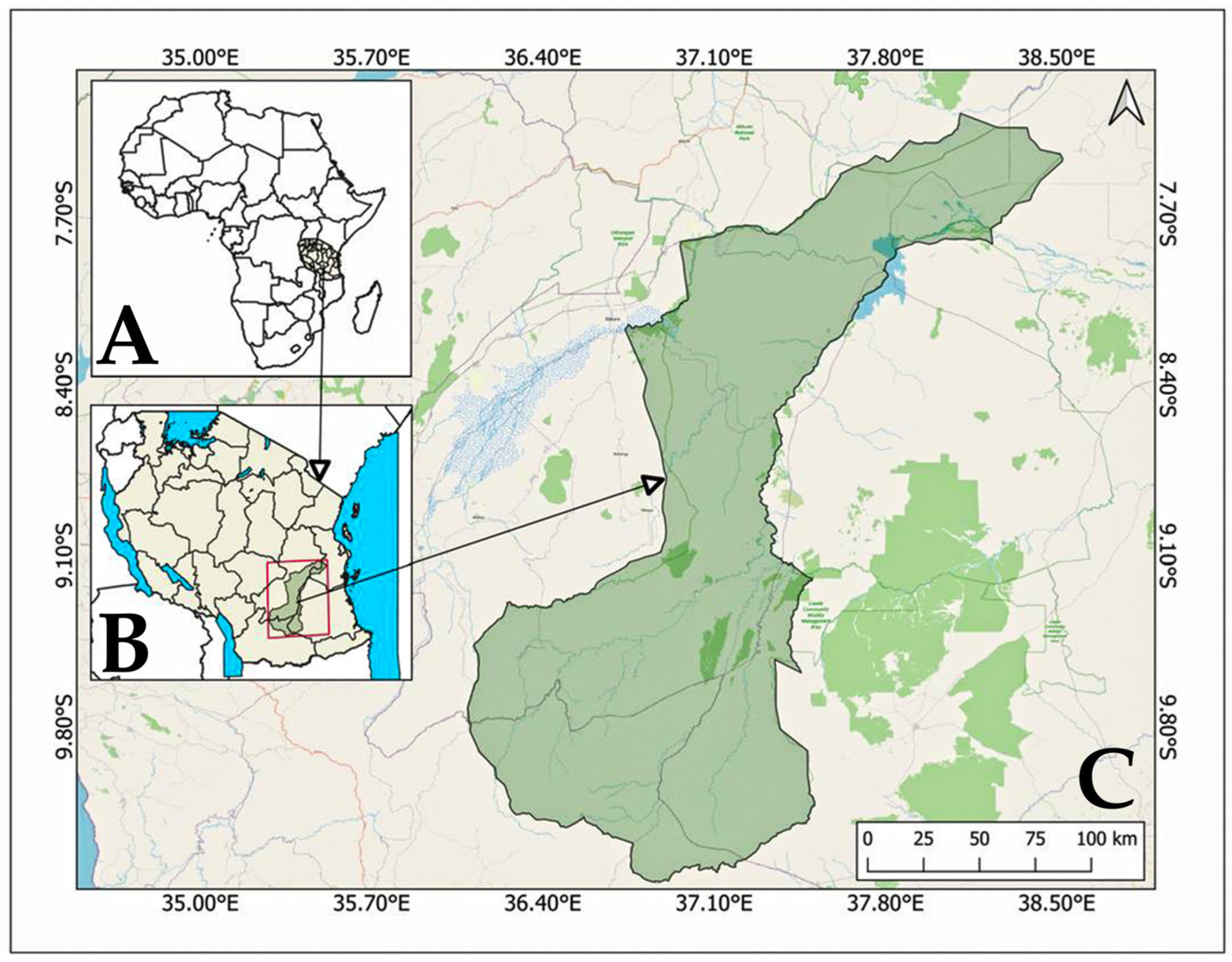
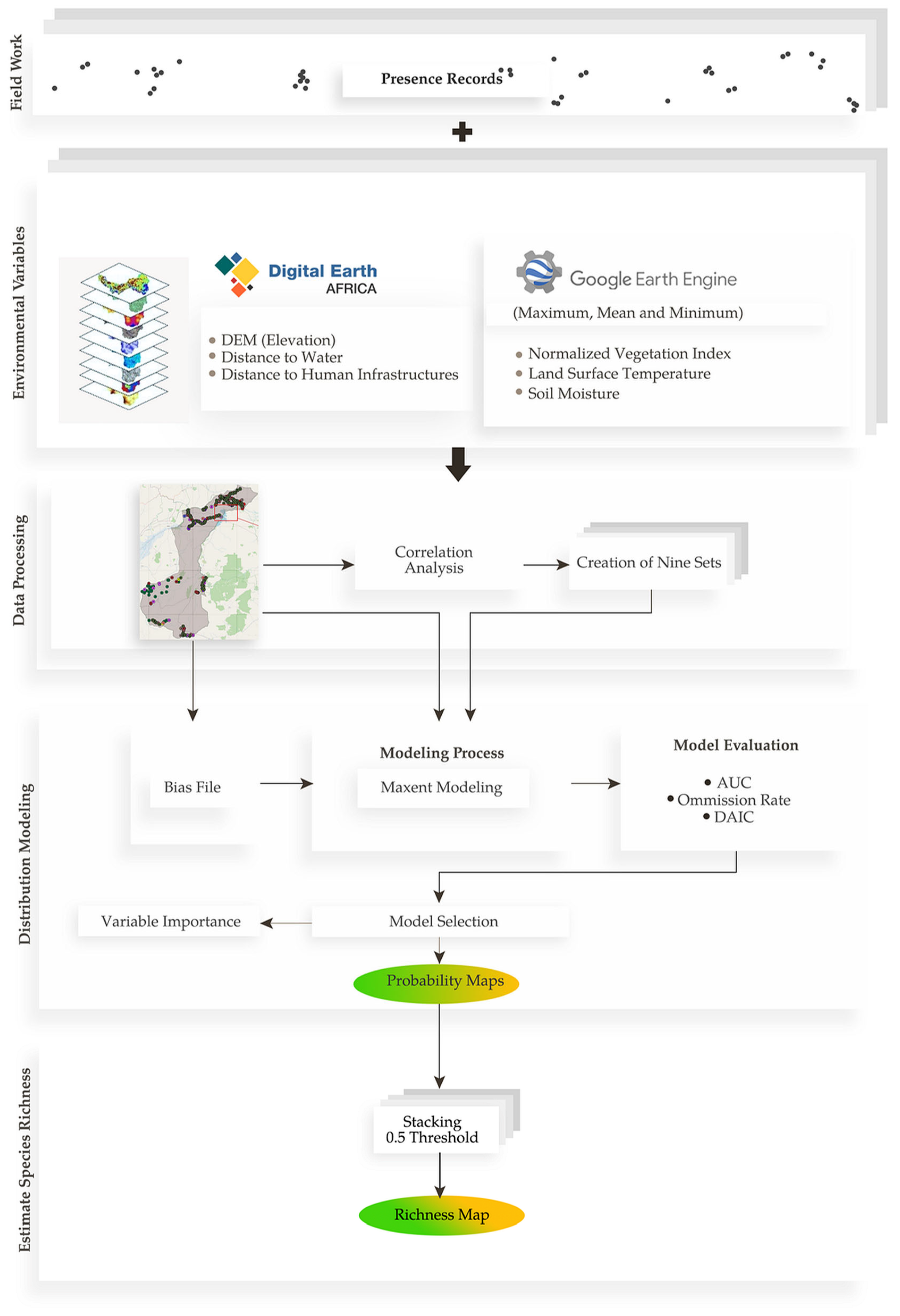
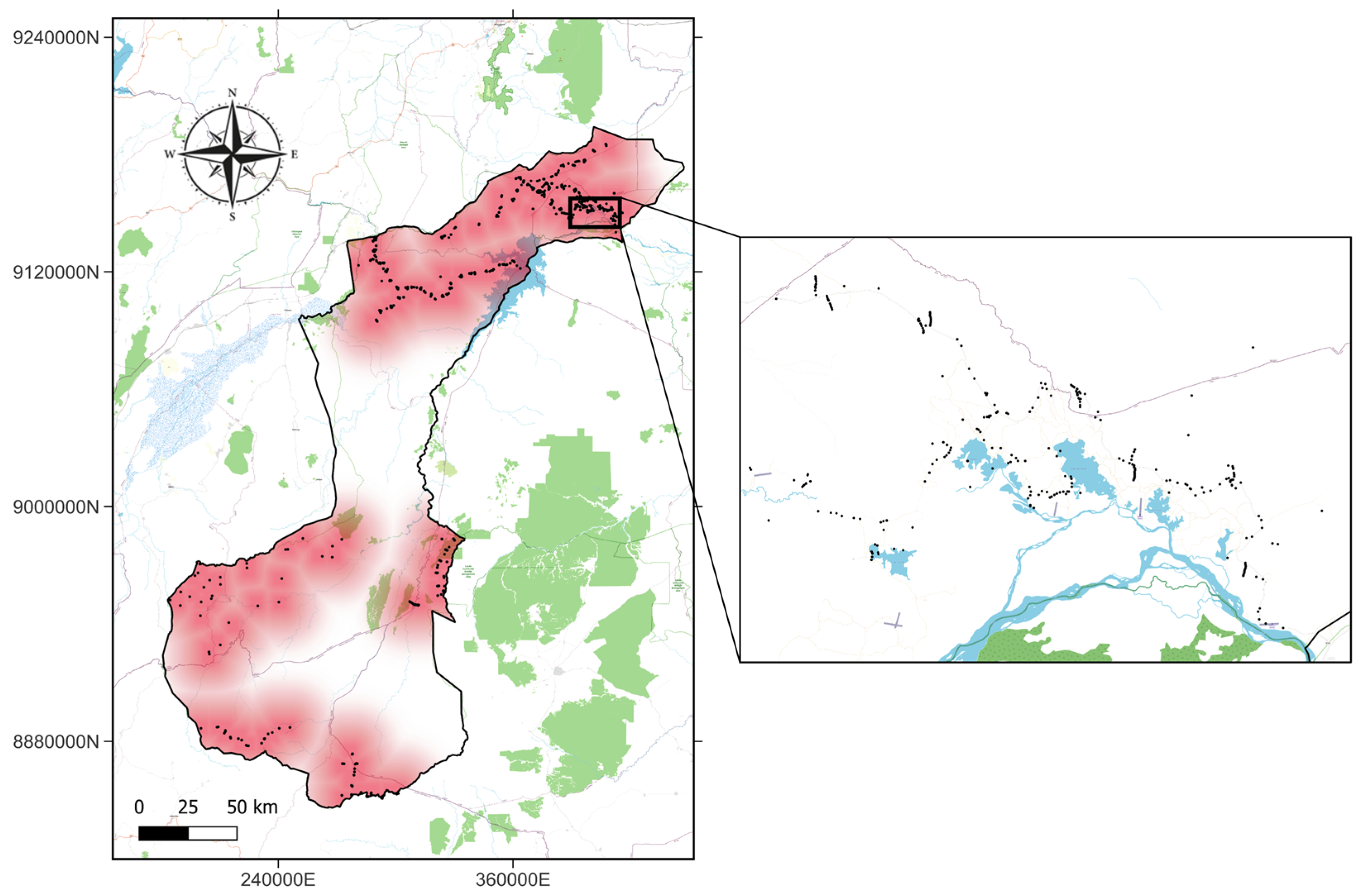
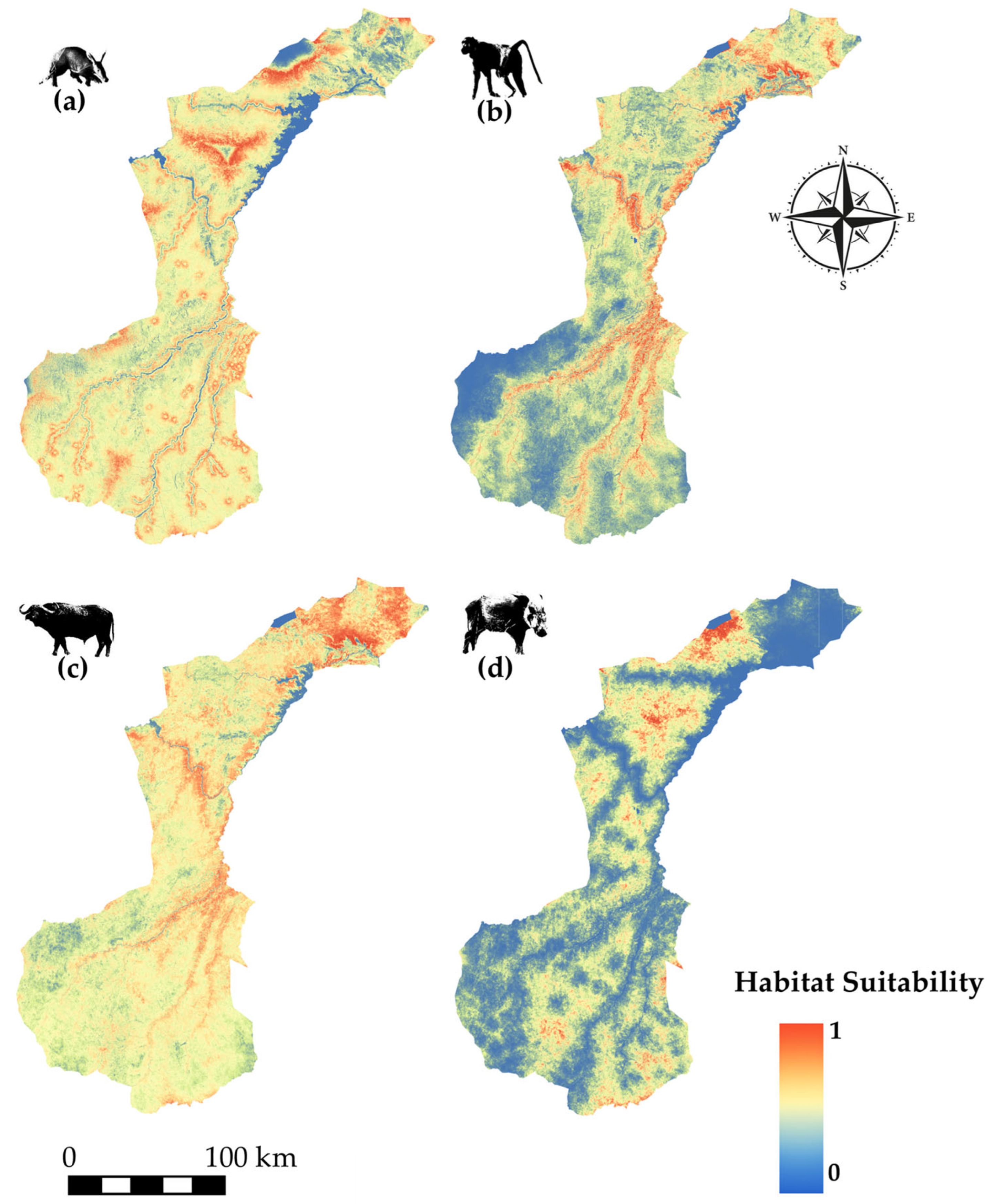
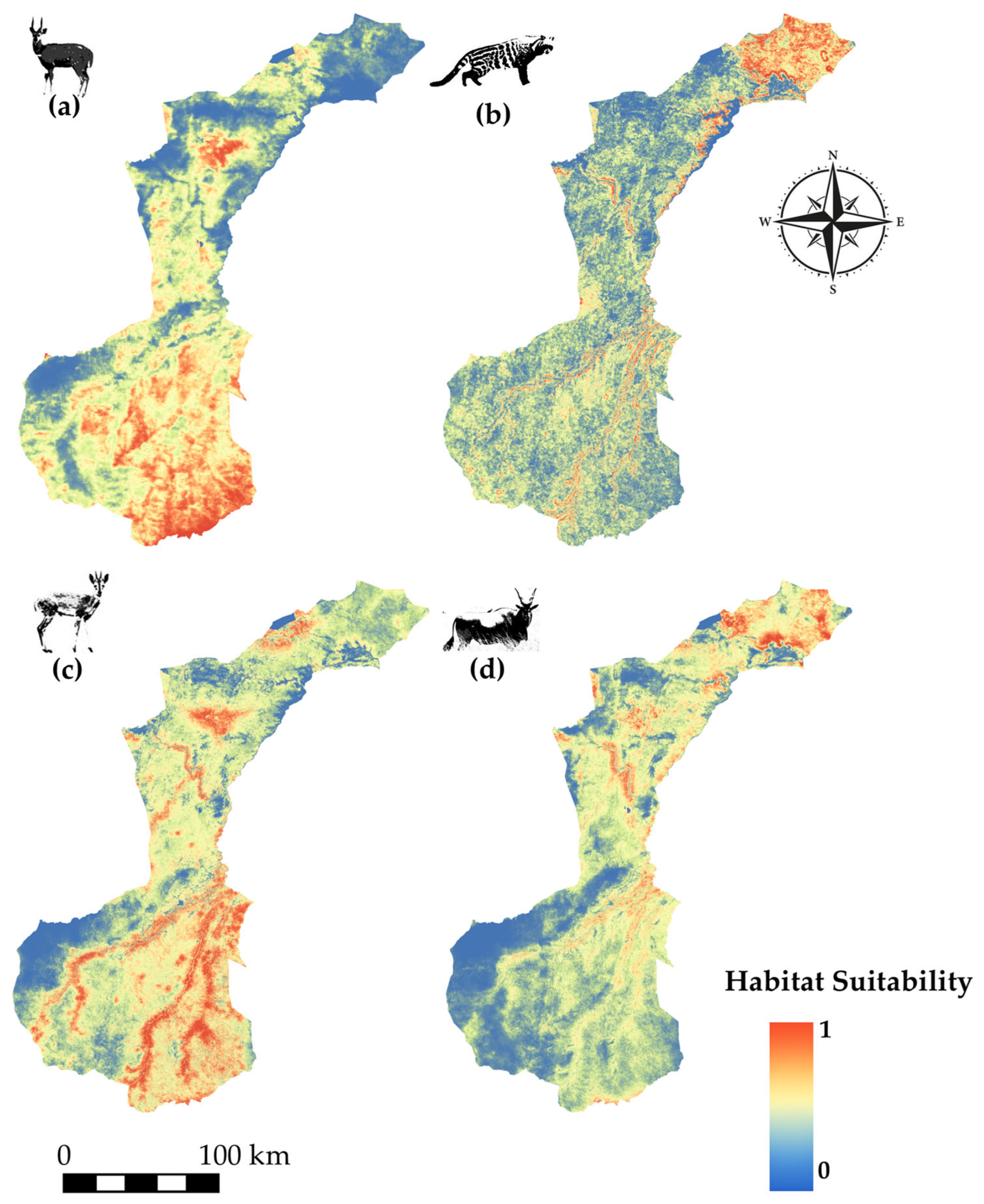
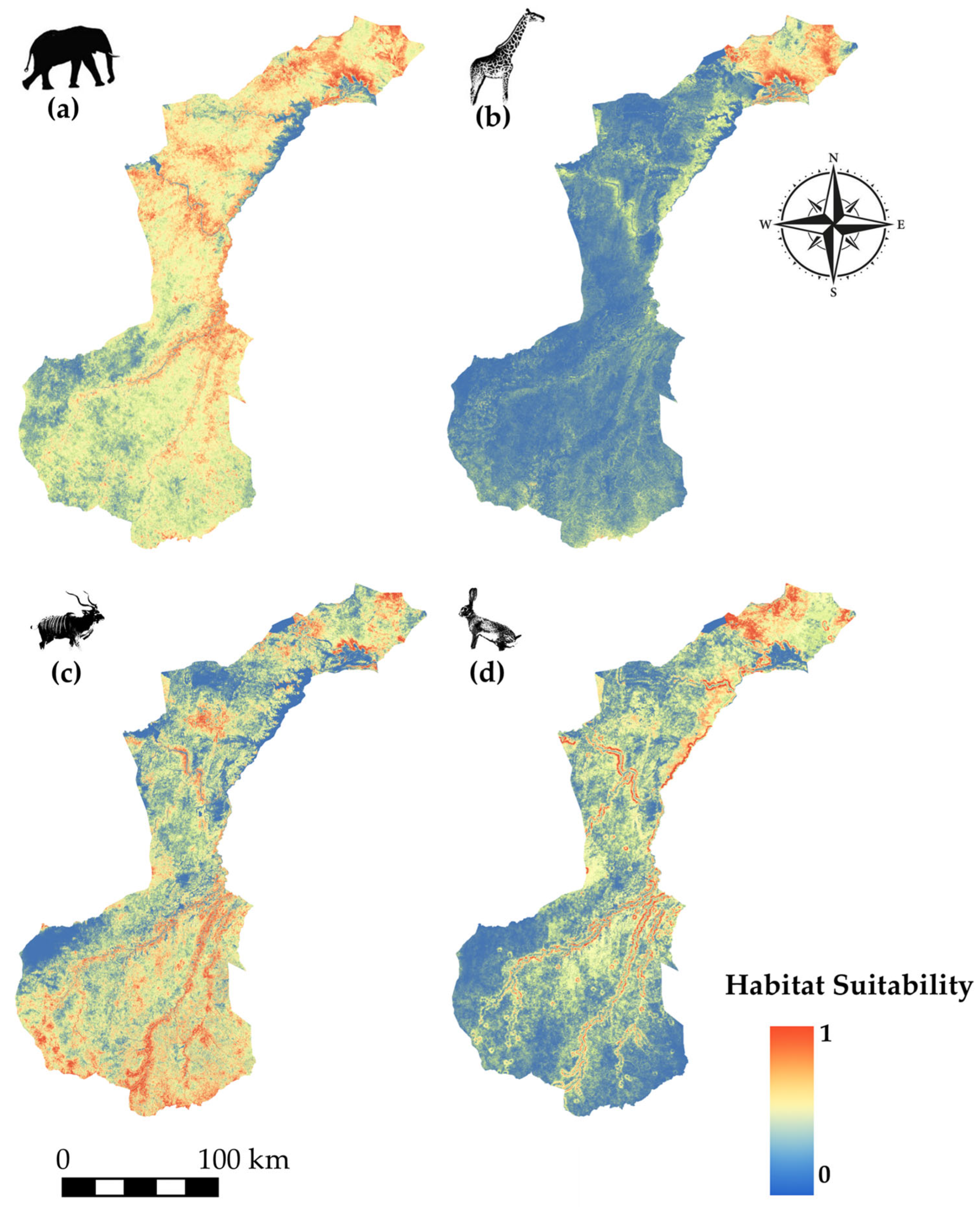

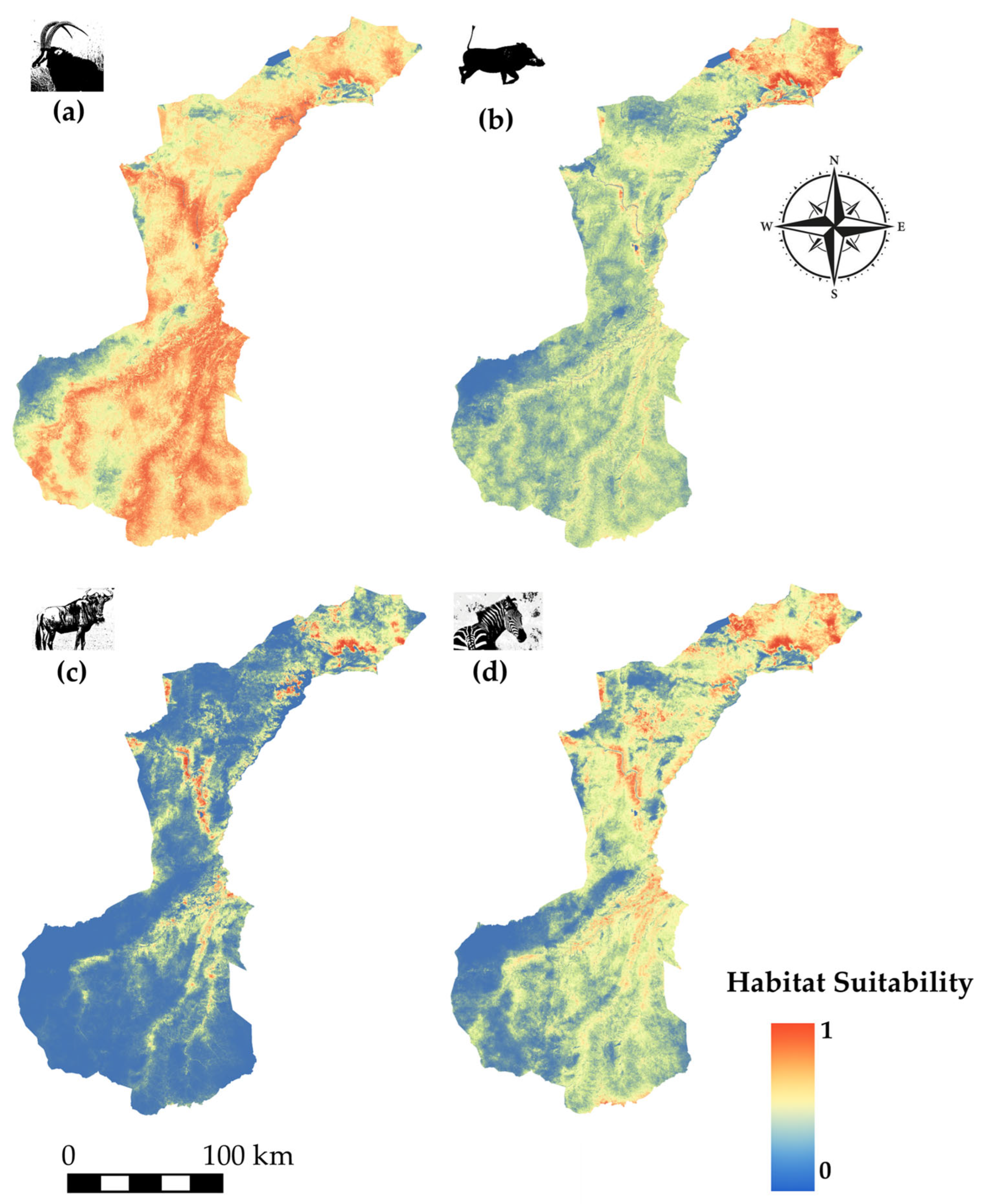

| Species | Scientific Name | Records |
|---|---|---|
| Bushbuck | Tragelaphus scriptus | 32 |
| African civet | Civettictis civetta | 27 |
| Bush pig | Potamochoerus larvatus | 25 |
| Sable antelope | Hippotragus niger | 30 |
| Lesser kudu | Tragelaphus imberbis | 31 |
| Greater Kudu | Tragelaphus strepsiceros | 44 |
| African savanna hare | Lepus victoriae | 48 |
| Yellow baboon | Papio cynocephalus | 60 |
| Common eland | Tragelaphus oryx | 70 |
| Aardvark | Orycteropus afer | 71 |
| Hippopotamus | Hippopotamus amphibius | 73 |
| Warthog | Phacochoerus africanus | 87 |
| Common duiker | Sylvicapra grimmia | 112 |
| Wildebeest | Connochaetes taurinus | 119 |
| Lichtenstein’s hartebeest | Alcelaphus lichtensteinii | 134 |
| Zebra | Equus quagga | 204 |
| Giraffe | Giraffa camelopardalis tippelskirchi | 229 |
| Impala | Aepyceros melampus | 268 |
| African buffalo | Syncerus caffer | 274 |
| African elephant | Loxodonta africana | 396 |
| Spatial Data/RS Product | Derived Variable (Units) | Notation | Source |
|---|---|---|---|
| MOD11A2.061 Terra Land Surface Temperature and Emissivity 8-Day Global 1 km, National Aeronautics and Space Administration (NASA), Washington, DC, USA. | Minimum Land Surface Temperature (°C) | MIN_LST | [45,46] |
| Maximum Land Surface Temperature (°C) | MAX_LST | ||
| Mean Land Surface Temperature (°C) | MEAN_LST | ||
| USGS Landsat 8 Level 2, Collection 2, Tier 1, United States Geological Survey (USGS), Sioux Falls, SD, USA. | Minimum NDVI (%) | MIN_NDVI | [46,47] |
| Maximum NDVI (%) | MAX_NDVI | ||
| Mean NDVI (%) | MEAN_NDVI | ||
| Sentinel-1 SAR GRD: C-band Synthetic Aperture Radar and SPL4SMGP.007, European Space Agency (ESA), Paris, France. SMAP L4 Global 3-hourly 9 km Soil moisture, National Aeronautics and Space Administration (NASA), Washington, DC, USA. | Minimum Soil Moisture (%) | MIN_SM | [46,48] |
| Maximum Soil Moisture (%) | MAX_SM | ||
| Mean Soil Moisture (%) | MEAN_SM | ||
| Copernicus 30 m Digital Elevation Model, European Space Agency (ESA), Paris, France. | Elevation (m) | DEM | https://www.digitalearthafrica.org, (accessed on 17 April 2025) |
| DE Africa Waterbodies Historical Extent | Distance to water sources (m) | DIST_WATER | |
| OpenStreetMap (OSM), Geoscience Australia, Canberra, Australia. | Distance to human infrastructures (m) | POP_DIST |
| Variables | Set 1 | Set 2 | Set 3 | Set 4 | Set 5 | Set 6 | Set 7 | Set 8 | Set 9 |
|---|---|---|---|---|---|---|---|---|---|
| MAX_LST | X | X | X | X | X | X | X | X | X |
| DIST_WAT | X | X | X | X | X | X | X | X | X |
| MIN_NDVI | X | X | X | X | X | X | X | X | X |
| DEM | X | X | X | X | X | ||||
| POP_DIST | X | X | X | X | |||||
| MEAN_LST | X | X | X | X | |||||
| MIN_LST | |||||||||
| MIN_SM | X | X | X | X | |||||
| MEAN_SM | X | X | X | ||||||
| MAX_SM | X | X | |||||||
| MEAN_NDVI | X | X | X | X | X | ||||
| MAX_NDVI | X | X | X | X |
| Species | AUC | Omission Rate | dAIC | Selected Variable Set |
|---|---|---|---|---|
| Aardvark | 0.84 | 0.13 | 1.06 | 8 |
| African buffalo | 0.85 | 0.14 | 1.05 | 9 |
| African civet | 0.88 | 0.08 | 0.98 | 1 |
| African elephant | 0.89 | 0.14 | 0.97 | 8 |
| African savanna hare | 0.91 | 0.09 | 0.92 | 3 |
| Bush pig | 0.96 | 0.03 | 0.83 | 7 |
| Bushbuck | 0.86 | 0.06 | 1.03 | 3 |
| Common duiker | 0.85 | 0.09 | 1.04 | 8 |
| Common eland | 0.84 | 0.13 | 1.06 | 4 |
| Common warthog | 0.91 | 0.10 | 0.93 | 6 |
| Giraffe | 0.91 | 0.05 | 0.93 | 2 |
| Greater kudu | 0.88 | 0.09 | 1.35 | 3 |
| Lichtenstein’s hartebeest | 0.86 | 0.14 | 1.02 | 5 |
| Hippopotamus | 0.97 | 0.05 | 0.82 | 9 |
| Impala | 0.91 | 0.07 | 0.92 | 2 |
| Lesser kudu | 0.91 | 0.05 | 0.93 | 9 |
| Sable antelope | 0.81 | 0.12 | 1.14 | 6 |
| Wildebeest | 0.93 | 0.14 | 0.89 | 9 |
| Yellow baboon | 0.84 | 0.08 | 1.07 | 4 |
| Zebra | 0.84 | 0.07 | 1.09 | 4 |
| Ranked Variable Importance (%) | ||||
|---|---|---|---|---|
| Species | First | Second | Third | Fourth |
| Lesser kudu | DEM (75) | MAX_LST (20.2) | MIN_NDVI (3.3) | DIST_WAT (1.2) |
| Impala | DEM (63.8) | MAX_NDVI (21.3) | DIST_WAT (4.9) | MAX_LST (4.6) |
| Hippopotamus | DIST_WAT (63) | DEM (17) | MAX_LST (9.5) | MAX_NDVI (8.5) |
| Common warthog | MEAN_LST (57.1) | POP_DIST (13.2) | MAX_NDVI (11.7) | MIN_NDVI (10.8) |
| Aardvark | MEAN_LST (53.4) | POP_DIST (27.6) | DIST_WAT (15.6) | MIN_SM (3.4) |
| African civet | MEAN_NDVI (53.3) | DEM (20.1) | MIN_NDVI (10.6) | DIST_WAT (8.3) |
| Sable antelope | MAX_LST (52.5) | MAX_NDVI (19.8) | DIST_WAT (14.4) | POP_DIST (5.1) |
| Lichtenstein’s hartebeest | MIN_LST (48.4) | MAX_LST (17.7) | POP_DIST (12.2) | DIST_WAT (8.3) |
| Bush buck | DEM (48.2) | MAX_LST (42) | DIST_WAT (8.3) | MAX_NDVI (1.5) |
| Yellow baboon | MAX_NDVI (48) | DEM (26.4) | DIST_WAT (9.3) | MIN_NDVI (7.7) |
| Zebra | MAX_LST (45.7) | DIST_WAT (15.2) | DEM (13.1) | MAX_NDVI (12.7) |
| Giraffe | DEM (42.3) | MAX_LST (25.3) | MAX_NDVI (18.7) | DIST_WAT (6.2) |
| African elephant | MEAN_LST (40.7) | POP_DIST (14.4) | MIN_SM (13.6) | MAX_NDVI (13) |
| African savanna hare | DEM (38.4) | MEAN_NDVI (31.6) | DIST_WAT (15.9) | MAX_LST (10.2) |
| Bush pig | DIST_WAT (38.1) | MEAN_LST (35) | MAX_LST (10.8) | POP_DIST (9.5) |
| Greater Kudu | MAX_LST (38.1) | MEAN_NDVI (26.4) | DEM (15.2) | MIN_NDVI (9.4) |
| Common duiker | MEAN_LST (37.3) | DIST_WAT (27.3) | MAX_NDVI (13.2) | POP_DIST (9.9) |
| African buffalo | DEM (34.9) | MAX_NDVI (31.9) | MAX_LST (12.8) | MIN_NDVI (11.3) |
| Common eland | MAX_LST (34.5) | MAX_NDVI (29.7) | MEAN_SM (11.4) | POP_DIST (9.4) |
| Wildebeest | MAX_LST (32.6) | DEM (29.8) | MAX_NDVI (17.3) | DIST_WAT (13.1) |
Disclaimer/Publisher’s Note: The statements, opinions and data contained in all publications are solely those of the individual author(s) and contributor(s) and not of MDPI and/or the editor(s). MDPI and/or the editor(s) disclaim responsibility for any injury to people or property resulting from any ideas, methods, instructions or products referred to in the content. |
© 2025 by the authors. Licensee MDPI, Basel, Switzerland. This article is an open access article distributed under the terms and conditions of the Creative Commons Attribution (CC BY) license (https://creativecommons.org/licenses/by/4.0/).
Share and Cite
Massawe, G.; Casas, E.; Marealle, W.; Lyamuya, R.; Mzumara, T.I.; Mbewe, W.; Arbelo, M. Modeling the Distribution and Richness of Mammalian Species in the Nyerere National Park, Tanzania. Remote Sens. 2025, 17, 2504. https://doi.org/10.3390/rs17142504
Massawe G, Casas E, Marealle W, Lyamuya R, Mzumara TI, Mbewe W, Arbelo M. Modeling the Distribution and Richness of Mammalian Species in the Nyerere National Park, Tanzania. Remote Sensing. 2025; 17(14):2504. https://doi.org/10.3390/rs17142504
Chicago/Turabian StyleMassawe, Goodluck, Enrique Casas, Wilfred Marealle, Richard Lyamuya, Tiwonge I. Mzumara, Willard Mbewe, and Manuel Arbelo. 2025. "Modeling the Distribution and Richness of Mammalian Species in the Nyerere National Park, Tanzania" Remote Sensing 17, no. 14: 2504. https://doi.org/10.3390/rs17142504
APA StyleMassawe, G., Casas, E., Marealle, W., Lyamuya, R., Mzumara, T. I., Mbewe, W., & Arbelo, M. (2025). Modeling the Distribution and Richness of Mammalian Species in the Nyerere National Park, Tanzania. Remote Sensing, 17(14), 2504. https://doi.org/10.3390/rs17142504













